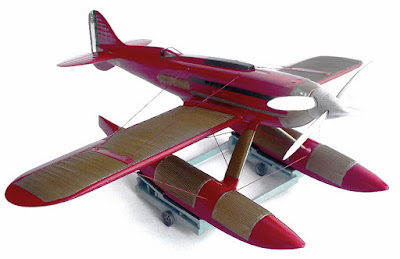Here are some images of Essdale Models 1/32 scale Macchi Castoldi MC-72 Schneider Racer.
This resin kit is from a few years back so as a result it has some of those "garage kit" qualities.
As a result the kit required a little extra work, but in the end produced a decent example.
From Wikipedia"
The Macchi M.C. 72 was an experimental seaplane designed and built by the Italian aircraft company Macchi Aeronautica. The M.C. 72 held the world speed record for all aircraft for five years. In 1933 and 1934, it set a world record speed for propeller-driven seaplanes which still stands to this day.
The Macchi M.C. 72 was one of a series of seaplanes developed by Macchi Aeronautica. An earlier model, the M.24 was a twin-engine flying boat armed with machine guns and capable of carrying a torpedo. Later in the 1920s, Macchi focused on speed and on winning the Schneider Trophy. In 1922, the company hired aircraft designer Mario Castoldi to design high-speed aircraft.
In 1926, the company won the trophy with the M.39 which attained a top speed of 396 km/h (246 mph). Further aircraft: the M.52, M.52R and the M.67, were designed and built but victory in the Schneider races kept eluding the Italians. Castoldi then designed the ultimate racing seaplane, the M.C. 72, a single-seater aircraft with two floats.
The M.C. 72 design was unique with a fuselage partly metal to the cockpit and wood monocoque bolted to the front tubular portion by four bolts. The streamlined nose contours enclosed an oil tank with its outside wall exposed to the airstream. The wing was all metal with flat tubular water radiators smoothly faired into the wings. The twin pontoons had three smoothly-faired radiators on the outer surfaces, the forward radiator for water and the centre and rear radiators for oil cooling. The float struts also featured water radiators and another radiator was fitted during hot conditions under the fuselage running from cockpit to tail.
The M.C. 72 was built in 1931 with the idea of competing for what turned out to be the final Schneider Trophy race, but due to engine problems, the M.C. 72 was unable to compete.
Instead of halting development, Macchi continued work on the M.C. 72. Benito Mussolini personally took an interest in seeing development of the M.C. 72 continue and directed state funds to the company.
For two years, the M.C. 72 suffered from many mechanical defects, as well as the loss of two test pilots who died trying to coax world class speed out of the M.C. 72 (first Monti and then Bellini). The final design of M.C. 72 used double, contra-rotating propellers powered by a modified FIAT AS-6 engine V24 engine generating some 1,900-2,300 kW (2,500-3,100 hp) (thanks to supercharging).
After 35 flights, the engines were overhauled in preparation for a record attempt. The aircraft finally lived up to expectations when it set a new world speed record (over water) on 10 April 1933, with a speed of 682 km/h (424 mph). It was piloted by Warrant Officer Francesco Agello (the last qualified test pilot). Not satisfied, development continued as the aircraft's designers thought they could break 700 km/h (430 mph) with the M.C. 72. This feat was in fact achieved on 23 October 1934, when Agello piloted the M.C. 72 for an average speed of 709 km/h (440 mph) over three passes. This record remains (as of 2012) the fastest speed ever attained by a piston-engine seaplane. After this success, the M.C.72 was never flown again.
The M.C. 72 held the world speed record for all aircraft for five years. For comparison, the record holder for a land-based aircraft was held (for a time) by the Hughes H-1 Racer with a top speed of only 566 km/h (352 mph). Then in 1939, two German racing aircraft passed the M.C. 72. The first was a Heinkel He 100 which reached the speed of 746 km/h (463 mph). The second was a Messerschmitt Me 209 which set a new world speed record of 756 km/h (469 mph) in August – just days before the start of World War II. The current world speed record for a piston-engine aircraft is 528.33 mph (850.26 km/h) set by a heavily modified American Grumman F8F Bearcat named Rare Bear over 3 km in 1989. However, the M.C. 72 record still stands today as the world's fastest propeller-driven seaplane.
One M.C. 72, the aircraft that took the world record, survives. It is on display at the Italian Air Force Museum, near Rome.
























